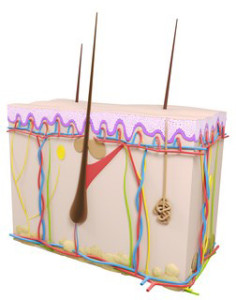 The skin plays the most crucial role in receiving the positive effects of bathing, since it forms the outermost layer of our body. Because it constitutes a natural barrier to factors originating in the external environment, it stands guard over our homeostasis. The total surface area of the skin is slightly less than two square metres and it can weigh up to ten kilos. In structure, it is layered; beginning from the outer layer, it is made up of the epidermis, the dermis and the subcutaneous tissue. It has appendages such as the sebaceous glands, the sweat glands and hairs and, in addition, it is amply supplied with blood and lymphatic vessels, as well as with numerous nerve endings.
The skin plays the most crucial role in receiving the positive effects of bathing, since it forms the outermost layer of our body. Because it constitutes a natural barrier to factors originating in the external environment, it stands guard over our homeostasis. The total surface area of the skin is slightly less than two square metres and it can weigh up to ten kilos. In structure, it is layered; beginning from the outer layer, it is made up of the epidermis, the dermis and the subcutaneous tissue. It has appendages such as the sebaceous glands, the sweat glands and hairs and, in addition, it is amply supplied with blood and lymphatic vessels, as well as with numerous nerve endings.
The skin covers and shields the internal organs and, at one and the same time, is related to them functionally.
The skin’s appearance and morphological characteristics differ, depending on age, sex, the body’s surroundings and environmental conditions. The colour of the skin depends on the thickness of the epidermis, the vascular supply and also on the melanin content, which is to say, on the skin’s natural pigment. The skin’s elasticity is manifest in the form of its resistance to stretching, pressure and mechanical injury.
The functions of the skin we consider as being the most vital are protection, defence against microorganisms, thermoregulation, the secretory function and the regulation of water, the absorptive function and the receptive function.
